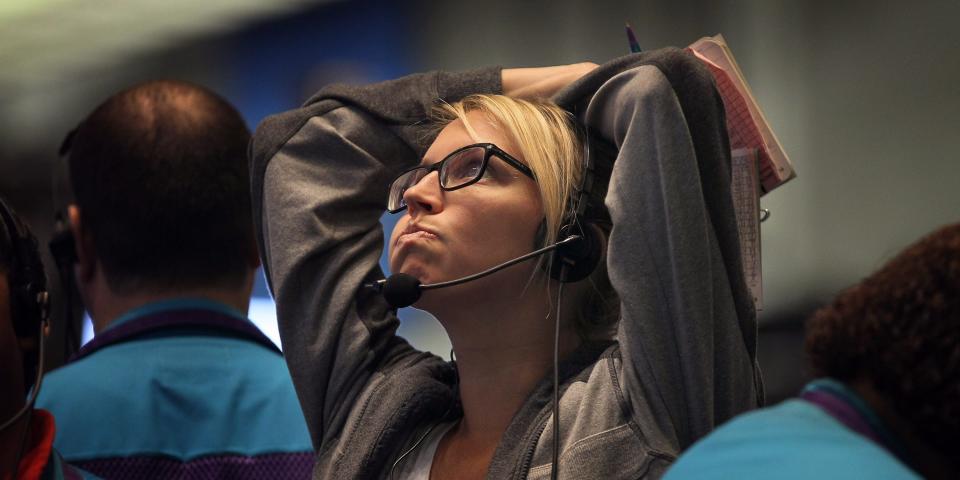
-
Stocks, crypto, and other assets have been hammered by market turmoil in recent days.
-
Recession fears, the Japanese yen, valuations, and the Fed’s next move fueled the chaos.
-
Some experts expect more pain for investors, while others say the sell-off was a blip.
Stock markets have been rocked by fresh recession fears, dour corporate earnings, and foreign monetary policy in recent days. Investors seem to have regained their composure, but experts warn the chaos may not be over.
What happened?
The S&P 500 tanked 8% from its July 16 peak to trade below 5,200 points at Wednesday’s close. The tech-heavy Nasdaq Composite has tumbled 13% over the same period, while bitcoin and ether have plunged 16% and 31% respectively since late July to revisit their February lows.
Nvidia, the microchip maker that has become the star stock of the artificial intelligence craze, has crashed 30% from an intraday peak of $141 on June 20 to $99 at Wednesday’s close. The sell-off slashed its market value from over $3.2 trillion to below $2.5 trillion.
The market rout reflects several headwinds converging to spook investors:
-
Friday’s jobs report showed the US economy added fewer jobs than expected, and unemployment ticked up to 4.3% — its highest level since October 2021. The news stoked concern on Wall Street that growth is slowing and company profits could suffer.
-
The Bank of Japan declared on July 31 that it would hike its benchmark interest rate in a bid to head off inflation and shore up its currency, and expected to further tighten its monetary policy. The announcement hammered Japanese stocks and fueled a global market sell-off, as investors rushed to unwind “carry trades” centered on borrowing cheaply in Japan and investing the funds in higher-yielding assets overseas. The central bank backtracked on Wednesday, saying it wouldn’t hike rates further for now.
-
A combination of rock-bottom US interest rates since the financial crisis, and historic amounts of government spending during and after the pandemic, drove the value of stocks, real estate, cryptocurrencies, and other risk assets to record highs. But the Federal Reserve has hiked rates from nearly zero to north of 5% since early 2022, boosting the relative appeal of safe assets like savings accounts and government bonds, and making it more costly for companies to borrow money to fuel growth. The Fed has held off on cutting rates as inflation remains well above its 2% target, which has maintained pressure on the economy.
-
Other factors include investor skepticism around the huge amounts of money being invested in AI with minimal payback so far; worries about the health of Big Tech after Tesla’s earnings nearly halved last quarter and Google-owner Alphabet reported slower advertising growth; and Warren Buffett’s Berkshire Hathaway revealing over the weekend that it slashed its monster Apple stake last quarter.
More pain to come?
US stocks climbed in early trading on Thursday, suggesting nerves have settled on Wall Street. But several experts have warned there could be more trouble ahead.
“The stock market looks like it is finally starting to correct,” reads one subhead in the latest research note from Paul Dietrich, the chief investment strategist at B. Riley Wealth Portfolio Advisers. He attributed the “massive stock market sell-off” to “fears of a looming US recession” stoked by worsening economic data, and warned the S&P 500 could eventually crash 40% from its recent highs.
Goldman Sachs’ Peter Oppenheimer told CNBC this week there’s lingering anxiety in markets that could fuel further volatility.
“My feeling is that this correction, although is stabilizing, is not yet over,” the bank’s chief global equity strategist said. “We’re still going to see, I think, some choppy environments in the short term as investors really start to calibrate and get more confident again about the direction of interest rates and the economy.”
Many investors hope the market slump and mounting signs of economic weakness will spur the Fed to start cutting rates, buoying asset prices. But veteran economist David Rosenberg warned investors against breathing a sigh of relief if that happens.
The Rosenberg Research president noted that after the Fed embarked on rate-cutting cycles in January 2001 and September 2007, recession struck a couple of months later in both cases. The S&P 500 also tanked by about 40% and 50% within the next couple of years both times.
“Now you know where the term ‘sucker’s rally’ comes from,” Rosenberg said.
He also pointed out that economists at JPMorgan recently raised their estimated probability of a recession this year from 25% to 35%, and Goldman’s economists now put the chances of a recession over the next year at 25%, up from 15%.
“Few asset classes are even remotely priced for those odds,” Rosenberg cautioned.
These experts’ comments suggest investors should brace for further market turmoil and potentially significant declines as recession looms larger, even if the Fed swoops in to save the day.
Positive sign
Other gurus aren’t so worried. In a recent note, Fundstrat’s Tom Lee pointed to a sharp decline in Wall Street’s “fear gauge” as reassuring. “VIX falling from 66 to 27 is a positive sign and further sign this is a ‘growth scare’ with the worst likely behind us.”
Nobody knows for sure where markets are headed next, with Wall Street split over whether the US economy is solid or crumbling, whether the AI boom is a bubble, and whether the Fed will start cutting rates in the next few weeks — and if it will be too little, too late.
But trading in recent days shows that even, and perhaps especially, the highest-flying assets can fall sharply when jittery investors get some bad news. If the bears are right, there could be more of the same ahead.
Read the original article on Business Insider
